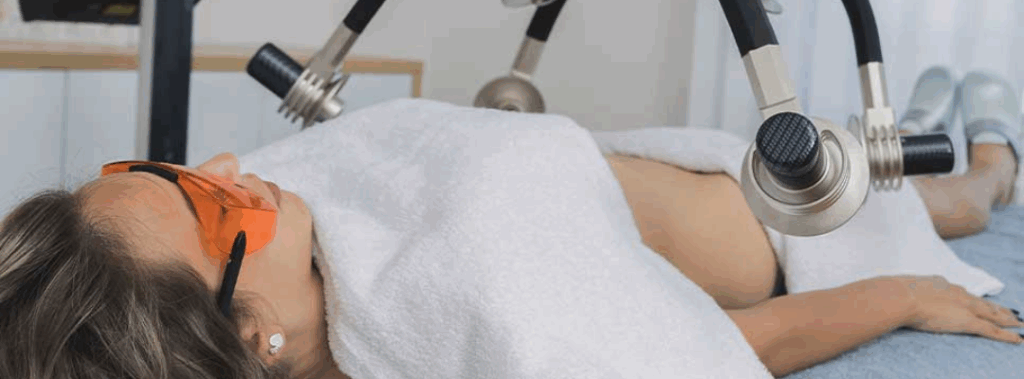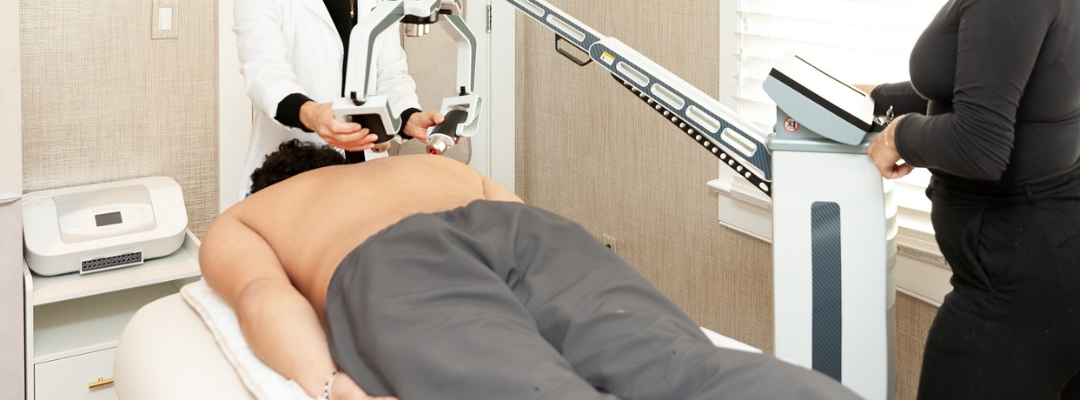
Men’s Health Month is an ideal opportunity to highlight emerging tools that empower men to take charge of their health and wellness. Low-level laser therapy (LLLT), also known as photobiomodulation, is gaining traction as a non-invasive, supportive treatment for a range of issues, including fat loss and recovery, inflammation, and chronic pain. For men seeking to enhance performance, mitigate risk factors for chronic illness, and maintain an active lifestyle, LLLT provides a science-backed solution that complements a holistic approach to health.
In this article, we’ll explore how LLLT supports key aspects of men’s health and why it may be worth discussing with your healthcare provider.
What Is Low-Level Laser Therapy (LLLT)?
LLLT uses red or near-infrared light to stimulate cells at a mitochondrial level. It is non-invasive, does not cut or burn tissue, and works by energizing cells to perform better. Unlike high-intensity surgical lasers, LLLT penetrates tissue gently to help support healing and balance.
It is being explored and in some cases FDA-cleared for applications including fat loss, inflammation reduction, and post-surgical healing support. Its versatility and gentle mechanism make it appealing for men seeking wellness solutions without the risks and recovery time of surgery or drugs.
LLLT for Muscle Recovery and Athletic Performance
A Common Goal Among Men
Many men engage in sports, weight training, or physically demanding jobs. Recovery is essential to performance, and prolonged soreness or fatigue can hinder consistency. Recovery tools like LLLT are gaining attention for their potential to accelerate healing and reduce discomfort.
The Role of LLLT in Muscle Recovery
Research shows that LLLT may help muscles recover faster after intense exercise by:
- Reducing inflammation and oxidative stress in muscle tissue
- Enhancing microcirculation and oxygen delivery
- Supporting mitochondrial energy production (ATP synthesis)
Why It Matters for Men’s Health
Improving recovery allows men to train more consistently, reduce the risk of overuse injuries, and maintain lean muscle mass, all of which are vital to aging well and supporting testosterone levels. It also enables more frequent activity, which further benefits cardiovascular and metabolic health.
Men’s Fat Loss and Body Composition
The Importance of Managing Weight in Men
Abdominal fat, especially visceral fat, is linked to a higher risk of heart disease, diabetes, and hormonal imbalances in men. According to the National Institute of Health, approximately 43% of U.S. adult men are obese. Even modest fat loss can dramatically reduce these risks. However, some fat areas are resistant to diet and exercise.
How LLLT May Aid Fat Reduction
LLLT has been FDA-cleared for non-invasive fat loss. It works by temporarily creating pores in fat cell membranes, allowing lipids to be released and processed by the lymphatic system. This process may support fat reduction without damaging surrounding tissues.
Why It Matters for Men’s Health
Fat loss around the abdomen not only improves physique but also reduces cardiovascular risk, supports hormone balance, and boosts confidence. LLLT offers a low-risk, time-efficient aid for men looking to enhance their results.
Heart Health Support with LLLT
A Leading Health Concern for Men
Heart health is a top priority for men’s health, as men develop heart disease 10 years earlier than women, on average. Cardiovascular disease remains the leading cause of death among men in the United States. Many of its risk factors, such as obesity, hypertension, and inflammation, are modifiable.
LLLT’s Supportive Role in Cardiovascular Health
While LLLT is not a treatment for heart disease, it has shown potential in supporting cardiovascular wellness indirectly by aiding fat loss. Fat loss, particularly around the abdomen, is one of the most significant ways men can reduce their cardiovascular risk. Excess visceral fat is associated with higher levels of systemic inflammation, insulin resistance, and elevated blood pressure – all key contributors to heart disease.
LLLT may support these improvements by:
- Encouraging the release of lipids from fat cells for metabolic processing
- Improving circulation and tissue oxygenation, which enhances exercise recovery and performance
- Reducing systemic inflammation linked to excess fat and metabolic strain
By helping men achieve healthier body composition and supporting better vascular function, LLLT may play a complementary role in broader heart health strategies when combined with exercise and diet.
Why It Matters for Men’s Health
Supporting cardiovascular function through gentle, non-invasive therapies can help men reduce reliance on pharmaceuticals and maintain better overall stamina, energy, and longevity.
Men’s Dental and Gum Health with LLLT
A Commonly Overlooked Issue
Men are more at risk of gum disease, making it an important factor in men’s health. According to the National Institute of Health, nearly 50% of men over the age of 30 show signs of periodontal disease, compared to 35% of women. Poor oral health is linked to increased risk of heart disease, stroke, and even erectile dysfunction.
How LLLT May Help
LLLT has demonstrated potential in dentistry for:
- Reducing gum inflammation and post-procedural pain
- Promoting faster healing and less discomfort
Why It Matters for Men’s Health
Oral health is often a gateway to systemic health. Supporting healthy gums and teeth with non-invasive options like LLLT may help reduce inflammation elsewhere in the body.
Using LLLT for Inflammation Management
Chronic Inflammation and Disease
Long-term inflammation is a silent driver of many men’s health concerns, from cardiovascular issues to joint pain and even mental health. Reducing inflammation is a cornerstone of longevity.
LLLT for Inflammation Support
LLLT has been used to support recovery from soft tissue injuries, arthritis, and other inflammatory conditions. It has been studied for its anti-inflammatory effects, particularly its ability to:
- Modulate cytokines involved in chronic inflammation
- Reduce oxidative damage
- Improve circulation to promote natural healing
Why It Matters for Men’s Health
Managing inflammation without daily medication use gives men more control over long-term wellness with fewer side effects. LLLT may serve as a safe, natural complement to diet and exercise.
Podiatric Health and Foot Pain in Men
Foot and Ankle Conditions in Men
Men who are active or on their feet for work may experience foot issues such as plantar fasciitis, Achilles tendinitis, neuropathic pain, or even fungal infections like athlete’s foot. These conditions can greatly impact mobility, daily function, and overall quality of life. Foot fungus, in particular, is a common issue among men, especially those who frequent locker rooms or wear closed shoes for long periods.
How LLLT Supports Podiatric Wellness
Emerging evidence suggests that phototherapy, including LLLT, may help reduce fungal colonization, especially when combined with antifungal treatments. Studies have also shown that LLLT may:
- Enhance blood flow to the foot and ankle
- Reduce inflammation and stiffness
- Support nerve regeneration and pain reduction
- Inhibit fungal growth by disrupting cellular structures in dermatophytes
Why It Matters for Men’s Health
Foot issues, from pain to infections, limit physical activity and contribute to sedentary lifestyles, which can increase cardiovascular risk. Maintaining foot health is a vital but often overlooked part of holistic wellness, especially as men age or increase physical activity levels.
Men’s Chronic Pain Management with LLLT
The Quiet Epidemic in Men
Chronic pain affects 1 in 5 American adults, but men are less likely to report it or seek care. Conditions like low back pain, joint degeneration, and repetitive use injuries are especially common. Pain not only affects daily function, but can also contribute to depression and social withdrawal.
The Role of LLLT in Pain Relief
LLLT has shown potential as a non-pharmaceutical pain aid by:
- Modulating inflammation in joints and soft tissue
- Enhancing local circulation for natural pain modulation
Why It Matters for Men’s Health
LLLT empowers men to manage chronic pain without dependence on medications, allowing them to remain physically active and engaged. Addressing pain proactively can also improve sleep, mood, and overall quality of life.
How LLLT Compares to Other Men’s Wellness Tools
LLLT stands out for men who want repeatable, low-risk options that integrate easily into their wellness plan. When considering LLLT as part of a health routine, it’s helpful to compare it to other treatment types:
- LLLT: Non-invasive, no downtime, drug-free, generally well tolerated
- Surgery: Invasive, high cost, weeks of downtime, higher complication risk
- Injections: Minimally invasive, moderate cost, short downtime
- Pharmaceuticals: May cause side effects, require ongoing use, variable effectiveness
Additional Men’s Health Tips
While LLLT can be an excellent support tool, it’s best used as part of a holistic wellness plan. Here are additional ways to improve men’s health naturally:
- Get Regular Sleep: Aim for 7–8 hours to support recovery and hormone balance
- Exercise Consistently: Combine strength and cardio for heart and metabolic health
- Eat Anti-Inflammatory Foods: Focus on vegetables, lean proteins, and healthy fats
- Stay Hydrated: Water supports circulation, joint health, and energy levels
- Manage Stress: Reduce inflammation with tools like meditation, journaling, or therapy
Consider LLLT as a Tool for Men’s Health
Low-level laser therapy is an exciting and gentle option that may support many aspects of men’s health, from performance and recovery to heart and oral health. For men seeking low-risk, drug-free options with minimal downtime, LLLT is worth considering.
Always consult your physician or licensed healthcare provider to determine if LLLT is appropriate for your unique needs and goals.



